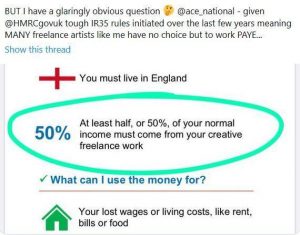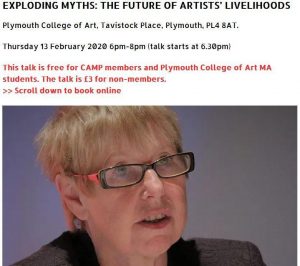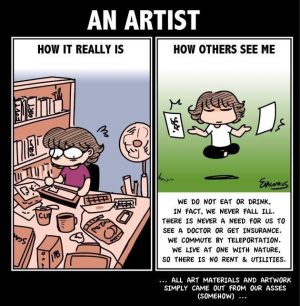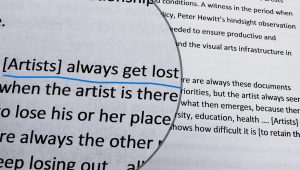
‘Artists always get lost…’
Delivering ‘human thriving’ in and through the arts, including fair pay for artists, in a pandemic world calls for substantial shifts in how arts policies are made and where they are realised.
Read “Leave no stone unturned, for artists’ sake” in full
Although 77% of visual artists are registered as self-employed (CCS, 2012), this bald statistic belies the nuance of how livelihoods are made up. This short text in the Covid19 portfolio contextualises artists’ income sources and concludes with a call for arts funders, arts organisations and the Higher Education sector to advocate strongly to ensure visual artists receive the support they deserve during the Covid19 emergency and in future.
Read “An exceptional case: visual artists and self-employment” in full
Presentation for CAMP (Contemporary Art Membership Plymouth) 13 February 2020 that addresses some of the myths about artists’ practices and livelihoods, the conditions most conducive for supporting the personal and professional lives of many artists over a life-cycle and provides some radical propositions for achieving them.
Read “Exploding myths: the future of artists' livelihoods” in full
Introduction to fees to artists for exhibiting in public with examples indicating that sustaining such schemes is dependent on widespread and continued acceptance of the principle and rigorous self-regulation within the sector, and on gaining suitable levels of public subsidy to the visual arts. Three financing options are considered in support of equanimity. An afterword considers whether in a political climate of reduced subsidy to the public sector, some new strategies are needed to finance the arts and artists’ contributions.
Read “Enforcement, equanimity and an afterword – thoughts on sustaining fair pay for artists” in full
This resource that includes commentary, evidence and advice is intended for individual artists, arts organisers, commissioners, trainers and policymakers intended to achieve equitable and inclusive conditions in which individuals can flourish. It’s a basis for exploring frictions and misassumptions about artists and pay and understanding why individual negotiation is a vital to ensuring productive exchanges and collaborations.
Read “Artists and pay - 20+ inspiration and information sources” in full

Cover: Working artists aspect of arts and labour
This essay for the 2014 Seoul Art Space, Seoul Foundation for Arts and Culture International Symposium briefly covers UK arts policies for support to artists’ development, comments on their impact on artists’ social and economic status and suggests a rethinking of the artists’ intrinsic role in society as a vital part of securing and sustaining contemporary visual arts in the future.
Read “Rethinking artists: the role of artists in the 21st Century” in full
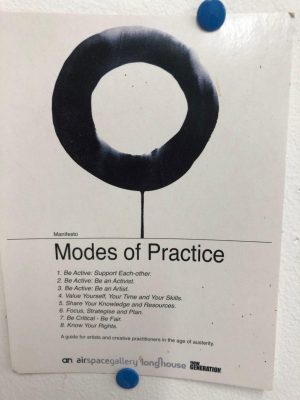
Modes of practice postcard
This provocation commissioned by Stoke Airspace for an Artists’ Soup Kitchen addresses and confirms the importance of the role and value of artists within cultural and social change. The four sections are designed to open up a discussion on ‘what now?’ and – more importantly – ‘what next?’ for Airspace and artists and future artists located in Stoke.
Read “Bite the hand that feeds you” in full

Annabel Dover: Too Many Artists Event
Drawing together comparative datasets and associated commentary, this paper given in 2011 is an exploration of the concept of ‘too many artists’ within discussion of the underlying premise of state interventions into the arts and differing policy perceptions over time of the artist’s role in society.
Read “Are there too many artists?” in full
Even in countries where there are well-developed fee and pay systems, there is evidence to demonstrate that artists’ wages remain unacceptably low. This is a baseline problem that few in the infrastructures for the arts seem willing to tackle and resolve.
Read “Artists’ low income and status are international issues” in full

